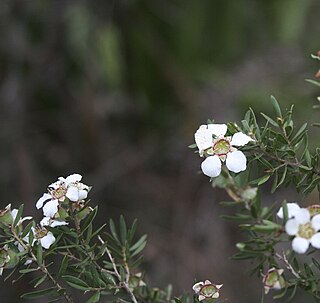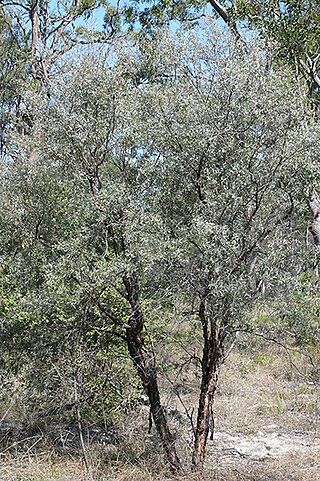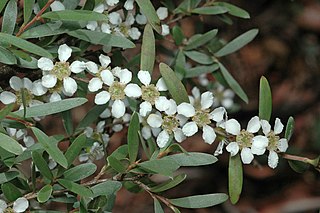
Bossiaea buxifolia, commonly known as matted bossiaea, is a species of flowering plant in the family Fabaceae and is endemic to south-eastern Australia. It is a prostrate to weakly erect shrub with elliptic to egg-shaped or almost round leaves and yellow, red and purplish flowers.

Gaudium trinervium, commonly known as flaky-barked tea-tree, slender tea-tree or paperbark tree, is a species of shrub or small tree that is endemic to eastern Australia. It has papery bark that is shed in thin, flaking layers, narrow elliptic to broadly egg-shaped leaves with the narrower at the base, white flowers and silky-hairy fruit that falls from the plant when mature.

Gaudium jingera, commonly known as the stringybark tea-tree, is a species of shrub that is endemic to Victoria, Australia. It has papery bark on the larger branches, smooth bark on the younger stems, narrow egg-shaped to elliptical leaves, white flowers and silky-hairy, hemispherical fruit.

Leptospermum juniperinum, commonly known as the prickly tea tree, is a species of broom-like shrub that is endemic to eastern Australia. It has narrow, sharply pointed leaves, white flowers usually arranged singly on short side shoots and small fruit that remain on the plant when mature.

Gaudium glaucescens, commonly known as the blue-green tea tree or smoky tea tree, is a species of shrub or small tree that is endemic to Tasmania. It has elliptical to egg-shaped leaves that are often greyish green, white flowers about 15 mm (0.59 in) in diameter arranged in consecutive leaf axils and fruit that remain on the plant for some time after maturity.

Gaudium coriaceum, commonly known as green tea-tree or mallee teatree, is a shrub species that is endemic to south-eastern and south-central Australia. It has smooth bark on the younger stems, elliptic to narrow egg-shaped leaves, white flowers and woody fruit. The usual habitat is mallee on sand dunes.

Gaudium parvifolium, commonly known as lemon-scented tea-tree, is a species of shrub that is endemic to eastern Australia. It has thin, rough bark, egg-shaped leaves with the narrower end towards the base, white or pink flowers, and fruit with the remains of the sepals attached but that is shed when the seeds are mature.

Gaudium deanei, commonly known as Deane's tea-tree, is a species of rare, slender shrub that is endemic to the northern suburbs of Sydney. It has bark peeling in long strips from the older stems, hairy young stems, narrow elliptical to lance-shaped leaves, white flowers arranged singly on short side shoots and mostly glabrous fruit.

Aggreflorum benwellii is a species of shrub that is endemic to the Nymboida National Park in New South Wales. It has smooth bark, young branches with conspicuous flanges, narrow elliptical leaves, white flowers and thin-walled, bell-shaped to hemispherical fruit.

Gaudium blakelyi is a species of shrub that is endemic to rocky clifftops near Lithgow in New South Wales. It has densely silky young stems, egg-shaped to elliptical leaves and white or pink flowers.

Gaudium brevipes, commonly known as the slender tea-tree, is a species of shrub or small tree that is endemic to eastern Australia. It has fibrous bark on the main stems, smooth bark on young stems, narrow elliptical to narrow egg-shaped leaves, white flowers and hemispherical fruit that is shed when mature.

Gaudium divaricatum is a species of plant that is endemic to inland New South Wales. It is an erect or weeping shrub with compact fibrous bark, elliptical to egg-shaped leaves, white flowers arranged singly on short axillary side shoots and woody fruit that fall off when mature.

Gaudium lamellatum is a species of shrub or small tree that is endemic to inland Queensland and has distinctive reddish, layered bark. It has narrow elliptical leaves, white flowers and small fruit that fall from the plant when mature.
Gaudium microcarpum is a species of shrub that is endemic to eastern Australia. It has elliptical to lance-shaped leaves with a sharp point on the tip, white flowers and small fruit that falls from the plant shortly after the seeds are released.

Gaudium namadgiense is a species of small shrub that is endemic to areas near the border between New South Wales and the Australian Capital Territory. It has silky-hairy, narrow lance-shaped to elliptical leaves, usually white flowers borne singly or in pairs on short side shoots, and fruit that falls from the plant shortly after the seeds are released.

Gaudium polyanthum is a rigid, spreading shrub or small tree that is endemic to New South Wales. It has thin, rough bark, young stems that are hairy at first, elliptical leaves, relatively small white flowers and fruit are shed when the seeds are mature.

Gaudium semibaccatum is a species of low, dense shrub that is endemic to eastern Australia. It has egg-shaped to narrow elliptical leaves with a blunt tip, white or pink flowers and hairy, flat-topped fruit that falls from the plant shortly after the seeds are released. It grows in poorly-drained soil in coastal heath.

Gaudium sericatum is a species of erect shrub that is endemic to Queensland. It has thin, firm bark, narrow egg-shaped to elliptical leaves, white or pink flowers arranged usually singly on side shoots and fruit that falls from the plant when the seeds are released.

Gaudium subglabratum is a species of open shrub that is endemic to a south-eastern New South Wales. It has thin, rough bark, egg-shaped to lance-shaped leaves with the narrower end towards the base, white flowers arranged singly on short side shoots and relatively small fruit that falls from the plant at maturity.
Pultenaea canescens, commonly known as plumed bush-pea, is a species of flowering plant in the family Fabaceae and is endemic to a small area in eastern New South Wales. It is an erect shrub with narrow elliptic to narrow egg-shaped leaves, and yellow to orange flowers with reddish-brown markings.



















